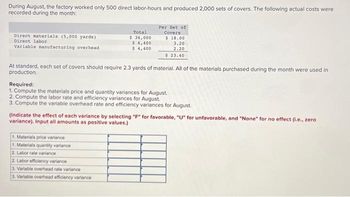
FINANCIAL ACCOUNTING
10th Edition
ISBN: 9781259964947
Author: Libby
Publisher: MCG
expand_more
expand_more
format_list_bulleted
Concept explainers
Topic Video
Question
Please do not give solution in image format thanku

Transcribed Image Text:During August, the factory worked only 500 direct labor-hours and produced 2,000 sets of covers. The following actual costs were
recorded during the month:
Direct materials (5,000 yards)
Direct labor
Variable manufacturing overhead
Total
$ 36,000
$ 6,400
$ 4,400
At standard, each set of covers should require 2.3 yards of material. All of the materials purchased during the month were used in
production.
Per Set of
Covers
$18.00
3.20
2.20
$ 23.40
Required:
1. Compute the materials price and quantity variances for August.
2. Compute the labor rate and efficiency variances for August.
3. Compute the variable overhead rate and efficiency variances for August.
1. Materials price variance
1. Materials quantity variance
2. Labor rate variance
(Indicate the effect of each variance by selecting "F" for favorable, "U" for unfavorable, and "None" for no effect (i.e., zero
variance). Input all amounts as positive values.)
2. Labor efficiency variance
3. Variable overhead rate variance
3. Variable overhead efficiency variance
![Problem 9-24 (Algo) Comprehensive Variance Analysis [LO9-4, LO9-5, LO9-6]
Marvel Parts, Incorporated, manufactures auto accessories. One of the company's products is a set of seat covers that can be adjusted
to fit nearly any small car. The company uses a standard cost system for all of its products. According to the standards that have been
set for the seat covers, the factory should work 630 hours each month to produce 2,100 sets of covers. The standard costs associated
with this level of production are:
Direct materials
Direct labor
Variable manufacturing overhead (based
on direct labor-hours)
Total
$ 38,640
$ 6,300
$ 3,150
Direct materials (5,000 yards)
Direct labor
Variable manufacturing overhead
Per Set of
Covers
Total
$ 36,000
$ 6,400
$ 4,400
$ 18.40
3.00
During August, the factory worked only 500 direct labor-hours and produced 2,000 sets of covers. The following actual costs were
recorded during the month:
1.50
$ 22.90
Per Set of
Covers
$ 18.00
3.20
2.20
$ 23.40
At standard, each set of covers should require 2.3 yards of material. All of the materials purchased during the month were used in
production.
Required:
1. Compute the materials price and quantity variances for August.
2. Compute the labor rate and efficiency variances for August.](https://content.bartleby.com/qna-images/question/ecb3ccf8-64a3-4f42-90b5-c9c7edf16923/e18068a6-2e4a-432b-9044-0b3be97728fe/jb19kp_thumbnail.jpeg)
Transcribed Image Text:Problem 9-24 (Algo) Comprehensive Variance Analysis [LO9-4, LO9-5, LO9-6]
Marvel Parts, Incorporated, manufactures auto accessories. One of the company's products is a set of seat covers that can be adjusted
to fit nearly any small car. The company uses a standard cost system for all of its products. According to the standards that have been
set for the seat covers, the factory should work 630 hours each month to produce 2,100 sets of covers. The standard costs associated
with this level of production are:
Direct materials
Direct labor
Variable manufacturing overhead (based
on direct labor-hours)
Total
$ 38,640
$ 6,300
$ 3,150
Direct materials (5,000 yards)
Direct labor
Variable manufacturing overhead
Per Set of
Covers
Total
$ 36,000
$ 6,400
$ 4,400
$ 18.40
3.00
During August, the factory worked only 500 direct labor-hours and produced 2,000 sets of covers. The following actual costs were
recorded during the month:
1.50
$ 22.90
Per Set of
Covers
$ 18.00
3.20
2.20
$ 23.40
At standard, each set of covers should require 2.3 yards of material. All of the materials purchased during the month were used in
production.
Required:
1. Compute the materials price and quantity variances for August.
2. Compute the labor rate and efficiency variances for August.
Expert Solution
This question has been solved!
Explore an expertly crafted, step-by-step solution for a thorough understanding of key concepts.
This is a popular solution
Trending nowThis is a popular solution!
Step by stepSolved in 5 steps

Knowledge Booster
Learn more about
Need a deep-dive on the concept behind this application? Look no further. Learn more about this topic, accounting and related others by exploring similar questions and additional content below.Similar questions
- How is the access control list approach different from RBAC?arrow_forwardPlease don't use chat gpt and other ai other wise I give multiplie downvote Which of the following is sometimes called a currently attainable standard? O a. par b. normal standard O c. theoretical standard d. ideal standardarrow_forwardDoes a user view always require multiple tables to support it? Explain.arrow_forward
- Write me a human paragraph without using Al about what a memorandoms of understanding is and how it is usedarrow_forwardThe easiest way to change the order in a chart is in the __________. Multiple Choice underlying spreadsheet slicer chart options chart itselfarrow_forwardInformation that is reported free from error ________.arrow_forward
arrow_back_ios
arrow_forward_ios
Recommended textbooks for you

 AccountingAccountingISBN:9781337272094Author:WARREN, Carl S., Reeve, James M., Duchac, Jonathan E.Publisher:Cengage Learning,
AccountingAccountingISBN:9781337272094Author:WARREN, Carl S., Reeve, James M., Duchac, Jonathan E.Publisher:Cengage Learning, Accounting Information SystemsAccountingISBN:9781337619202Author:Hall, James A.Publisher:Cengage Learning,
Accounting Information SystemsAccountingISBN:9781337619202Author:Hall, James A.Publisher:Cengage Learning, Horngren's Cost Accounting: A Managerial Emphasis...AccountingISBN:9780134475585Author:Srikant M. Datar, Madhav V. RajanPublisher:PEARSON
Horngren's Cost Accounting: A Managerial Emphasis...AccountingISBN:9780134475585Author:Srikant M. Datar, Madhav V. RajanPublisher:PEARSON Intermediate AccountingAccountingISBN:9781259722660Author:J. David Spiceland, Mark W. Nelson, Wayne M ThomasPublisher:McGraw-Hill Education
Intermediate AccountingAccountingISBN:9781259722660Author:J. David Spiceland, Mark W. Nelson, Wayne M ThomasPublisher:McGraw-Hill Education Financial and Managerial AccountingAccountingISBN:9781259726705Author:John J Wild, Ken W. Shaw, Barbara Chiappetta Fundamental Accounting PrinciplesPublisher:McGraw-Hill Education
Financial and Managerial AccountingAccountingISBN:9781259726705Author:John J Wild, Ken W. Shaw, Barbara Chiappetta Fundamental Accounting PrinciplesPublisher:McGraw-Hill Education


Accounting
Accounting
ISBN:9781337272094
Author:WARREN, Carl S., Reeve, James M., Duchac, Jonathan E.
Publisher:Cengage Learning,

Accounting Information Systems
Accounting
ISBN:9781337619202
Author:Hall, James A.
Publisher:Cengage Learning,

Horngren's Cost Accounting: A Managerial Emphasis...
Accounting
ISBN:9780134475585
Author:Srikant M. Datar, Madhav V. Rajan
Publisher:PEARSON

Intermediate Accounting
Accounting
ISBN:9781259722660
Author:J. David Spiceland, Mark W. Nelson, Wayne M Thomas
Publisher:McGraw-Hill Education

Financial and Managerial Accounting
Accounting
ISBN:9781259726705
Author:John J Wild, Ken W. Shaw, Barbara Chiappetta Fundamental Accounting Principles
Publisher:McGraw-Hill Education